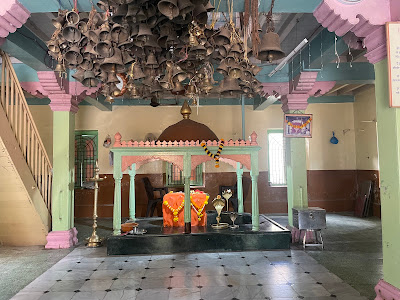This board gives the detailed history of Nageshwar mandir.
It’s a village on the west coast of India. A sadhu named Nagoba visited Rameshwar, Gokarna, Mahabaleshwar, Parshuram, Harihareshwar etc holy places and then from the south arrived at Awas to seek the darshan of Swayambhu Ganpati. This was about 500 years ago. He wished to go to Kankeshwar and therefore stayed at Awas. Here he was much loved and surrounded by people and therefore could not visit Kankeshwar. Inspite of that he revered Kankeshwar.
While in Awas he acquired two disciples Changoba and Budhoba. He had a little knowledge about medicine. SheshNarayan was the centre of his faith. He would have darshan of him in his dreams and in physical form. Once at the location where he bathe SheshNarayan appeared. It was dark and Baba grappled in the dark and found the snake. He handed over the snake to a disciple. That snake would slither on his body and since he was not harmed people found it miraculous. On the seashore too there was a Kevada forest which was infested with poison reptiles and animals. When Nagoba sadhu passed by these animals never harmed him inspite of these reptiles and animals crossing his path.
Nageshwar Yatra
After Nagoba Sadhu’s arrival in Awas, this little village showed signs of prosperity. The rains were timely and hence harvests improved. Overall health of people improved and epidemics vanished. The fear of poisonous animals withered away from people’s minds. He lived here for many years and had a very large following of people. He believed that the love of people and their devotion may not last. So he decided to take samadhi in Awas. Accordingly he instructed his disciples to dig up a pit. He announced it to his followers that a samadhi will take place in the same place where he sits. After the pit was dug it was lined with wild Darbha grass. Then people did pooja and offered naivedya to him. Pleased with this display of love and devotion by his disciples and followers. He declared that after his samadhi they will find 3 idols of snakes in that very place on wood. If people worship these idols and wish for fulfilment they will come true. There will be prosperity, unhappiness will be destroyed and people will live happily. After him he assigned the management to Rane family. He instructed that after his samadhi on the that day every year. The snake form appearing on the wood should be carried to Kankeshwar every year on the tithi for darshan amidst chanting of NARAYAN. Ever since on the second of yatra the ritual of carrying the Nagoba form in a palakhi. It is first paraded in Awas village and then is carried to Kankeshwar for darshan. Thus the tradition was established. Along with Nagoba sadhu his 2 prominent disciples Changoba and Budhoba also followed in with Samadhi. After Samadhi for 3 days milk was fed to them through a pipe. After the 3rd day and end of their life the milk stopped passing through and returned in the pipe. That day is recorded as Kartik Shukla Trayodashi Bharani Nakshatra.
After samadhi Nagoba showed him presence in the form of possession in the Rane family. Lives of many people who have been bitten by a poisonous snake have been saved here by mere bringing the victim to Nageshwar. As informed by Nagoba Sadhu we are able to worship the three snake forms on wood here.
As per this history of Nagoba sadhu Kartik Shuddha Chaturdashi is celebrated every year as a remembrance of the samadhi with Jatra. This jatra in Awas is the biggest one in Alibag.
A large number of people come to worship there. We wish for relief from suffering and once wish is fulfilled they offer metal bells as a sign of gratitude. The bells are tied in the sanctorium amidst loud chanting of Nagoba Dev !















No comments:
Post a Comment